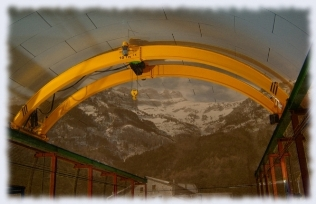Speaker
Teresa Kurtukian Nieto
(Centre National de la Recherche Scientifique (FR))
Description
The heavy ion fusion reaction 16O+ 16O is an important reaction in nuclear astrophysics since it influences not only the nucleosynthesis but also the subsequent stellar evolution [1]. At present, this reaction has only been measured down to energies around 6.5 MeV that are higher than the energies of astrophysical interest. The main reasons for this are limitations in detector efficiencies, background reduction and reaction yields. An extrapolation towards the relevant astrophysical energies is the only recourse with the existing experimental data.
Recently Diaz-Torres et al. [2] investigated the impact of nuclear molecular configurations on the astrophysical S-factor from 16O+16O. They found a pronounced maximum around 4.5 MeV in the S-factor excitation function. The experimental study of the 16O+16O fusion reaction at energies between 4 MeV and 6 MeV is important to verify such effect. The expected cross sections range between 10-11 mb at 4 MeV and 10-4 mb at 6 MeV.
AIFIRA (Applications Interdisciplinaires des Faisceaux d’ions en Région Aquitaine) is a facility installed at CENBG, Bordeaux, France, that consist of a 3.5 MV in-line Singleton accelerator of HVEE Company and five beam lines that confers a lot of possibilities for chemical analysis and nuclear physics [3]. The choice of this accelerator was motivated by high beam brightness and energy stability considerations, which are mandatory for micrometric and sub-micrometric beams production. The tank is filled with 6.3 bars of SF6 that ensures a good dielectric insulation. The radio-frequency (RF) source allows for the production of 1H+, 2H+ and 4He+ ion beams with intensities ranging from few hundred nA up to 80 μA. This kind of RF source is able to produce beams of other gaseous ions including nitrogen, oxygen, neon, argon, krypton, iodine and xenon. For the study of 16O+16O reactions at CUNA, it will be interesting to consider a technical solution for the accelerator and ion source that produces high intensity oxygen beams. From our experience at AIFIRA, the combination of a singleton coupled with an RF source could allows one to get up to 125 μA of oxygen beam and an energy stability of 2.5 10-5.
[1] C. E. Rolfs and W. S. Rodney, Cauldrons in the Cosmos. University of Chicago Press, Chicago, 1988
[2] A. Diaz-Torres et al., Phys. Lett. B 652, 255 (2007)
[3] S. Sorieul et al., Nucl. Instr. Methods B, 332, 68, (2014)
Recently Diaz-Torres et al. [2] investigated the impact of nuclear molecular configurations on the astrophysical S-factor from 16O+16O. They found a pronounced maximum around 4.5 MeV in the S-factor excitation function. The experimental study of the 16O+16O fusion reaction at energies between 4 MeV and 6 MeV is important to verify such effect. The expected cross sections range between 10-11 mb at 4 MeV and 10-4 mb at 6 MeV.
AIFIRA (Applications Interdisciplinaires des Faisceaux d’ions en Région Aquitaine) is a facility installed at CENBG, Bordeaux, France, that consist of a 3.5 MV in-line Singleton accelerator of HVEE Company and five beam lines that confers a lot of possibilities for chemical analysis and nuclear physics [3]. The choice of this accelerator was motivated by high beam brightness and energy stability considerations, which are mandatory for micrometric and sub-micrometric beams production. The tank is filled with 6.3 bars of SF6 that ensures a good dielectric insulation. The radio-frequency (RF) source allows for the production of 1H+, 2H+ and 4He+ ion beams with intensities ranging from few hundred nA up to 80 μA. This kind of RF source is able to produce beams of other gaseous ions including nitrogen, oxygen, neon, argon, krypton, iodine and xenon. For the study of 16O+16O reactions at CUNA, it will be interesting to consider a technical solution for the accelerator and ion source that produces high intensity oxygen beams. From our experience at AIFIRA, the combination of a singleton coupled with an RF source could allows one to get up to 125 μA of oxygen beam and an energy stability of 2.5 10-5.
[1] C. E. Rolfs and W. S. Rodney, Cauldrons in the Cosmos. University of Chicago Press, Chicago, 1988
[2] A. Diaz-Torres et al., Phys. Lett. B 652, 255 (2007)
[3] S. Sorieul et al., Nucl. Instr. Methods B, 332, 68, (2014)
Primary author
Teresa Kurtukian Nieto
(Centre National de la Recherche Scientifique (FR))




